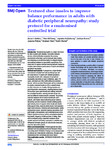Textured shoe insoles to improve balance performance in adults with diabetic peripheral neuropathy: study protocol for a randomised controlled trial
| dc.contributor.author | Hatton, AL | |
| dc.contributor.author | Gane, EM | |
| dc.contributor.author | Maharaj, JN | |
| dc.contributor.author | Burns, J | |
| dc.contributor.author | Paton, Joanne | |
| dc.contributor.author | Kerr, G | |
| dc.contributor.author | Rome, K | |
| dc.date.accessioned | 2019-10-22T07:38:35Z | |
| dc.date.available | 2019-10-22T07:38:35Z | |
| dc.date.issued | 2019-07-17 | |
| dc.identifier.issn | 2044-6055 | |
| dc.identifier.issn | 2044-6055 | |
| dc.identifier.other | ARTN e026240 | |
| dc.identifier.uri | http://hdl.handle.net/10026.1/15002 | |
| dc.description.abstract |
<jats:sec><jats:title>Introduction</jats:title><jats:p>Peripheral neuropathy is a major risk factor for falls in adults with diabetes. Innovative footwear devices which artificially manipulate the sensory environment at the feet, such as textured shoe insoles, are emerging as an attractive option to mitigate balance and walking problems in neuropathic populations. This study aims to explore whether wearing textured insoles for 4 weeks alters balance performance in adults with diabetic peripheral neuropathy.</jats:p></jats:sec><jats:sec><jats:title>Methods and analysis</jats:title><jats:p>A prospective, single-blinded randomised controlled trial with parallel groups will be conducted on 70 adults with diabetic peripheral neuropathy. Adults with a diagnosis of peripheral neuropathy (secondary to type 2 diabetes), aged ≥18 years, ambulant over 20 m (with/without an assistive device), will be recruited. Participants will be randomised to receive a textured insole (n=35) or smooth insole (n=35), to be worn for 4 weeks. During baseline and post intervention assessments, standing balance (foam/firm surface; eyes open/closed) and walking tasks will be completed barefoot, wearing standard shoes only, and two different insoles (smooth, textured). The primary outcome measure will be centre of pressure (CoP) velocity, with higher values indicating poorer balance. Secondary outcome measures include walking quality (gait velocity, base of support, stride length and double-limb support time), physical activity levels, foot sensation (light-touch pressure, vibration) and proprioception (ankle joint position sense), and other balance parameters (CoP path length, anteroposterior and mediolateral excursion). Patient-reported outcomes will be completed evaluating foot health, frequency of falls and fear of falling. Data will be analysed using a repeated measures mixed models approach (including covariates) to establish any differences between-groups, for all outcome measures, over the intervention period.</jats:p></jats:sec><jats:sec><jats:title>Ethics and dissemination</jats:title><jats:p>Ethical approval has been obtained from the institutional Human Research Ethics Committee (#2017000098). Findings will be disseminated at national and international conferences, through peer-reviewed journals, workshops and social media.</jats:p></jats:sec><jats:sec><jats:title>Trial registration number</jats:title><jats:p>ACTRN12617000543381; Pre-results.</jats:p></jats:sec> | |
| dc.format.extent | e026240-e026240 | |
| dc.format.medium | Electronic | |
| dc.language | en | |
| dc.language.iso | en | |
| dc.publisher | BMJ Publishing Group | |
| dc.subject | diabetes and endocrinology | |
| dc.subject | diabetic neuropathy | |
| dc.subject | preventative medicine | |
| dc.subject | rehabilitation medicine | |
| dc.subject | Accidental Falls | |
| dc.subject | Diabetic Neuropathies | |
| dc.subject | Equipment Design | |
| dc.subject | Humans | |
| dc.subject | Postural Balance | |
| dc.subject | Randomized Controlled Trials as Topic | |
| dc.subject | Shoes | |
| dc.title | Textured shoe insoles to improve balance performance in adults with diabetic peripheral neuropathy: study protocol for a randomised controlled trial | |
| dc.type | journal-article | |
| dc.type | Clinical Trial Protocol | |
| dc.type | Journal Article | |
| dc.type | Research Support, Non-U.S. Gov't | |
| plymouth.author-url | https://www.webofscience.com/api/gateway?GWVersion=2&SrcApp=PARTNER_APP&SrcAuth=LinksAMR&KeyUT=WOS:000485269700205&DestLinkType=FullRecord&DestApp=ALL_WOS&UsrCustomerID=11bb513d99f797142bcfeffcc58ea008 | |
| plymouth.issue | 7 | |
| plymouth.volume | 9 | |
| plymouth.publication-status | Published | |
| plymouth.journal | BMJ Open | |
| dc.identifier.doi | 10.1136/bmjopen-2018-026240 | |
| plymouth.organisational-group | /Plymouth | |
| plymouth.organisational-group | /Plymouth/Faculty of Health | |
| plymouth.organisational-group | /Plymouth/Faculty of Health/School of Health Professions | |
| plymouth.organisational-group | /Plymouth/REF 2021 Researchers by UoA | |
| plymouth.organisational-group | /Plymouth/REF 2021 Researchers by UoA/UoA03 Allied Health Professions, Dentistry, Nursing and Pharmacy | |
| plymouth.organisational-group | /Plymouth/Research Groups | |
| plymouth.organisational-group | /Plymouth/Research Groups/Institute of Health and Community | |
| plymouth.organisational-group | /Plymouth/Users by role | |
| plymouth.organisational-group | /Plymouth/Users by role/Academics | |
| plymouth.organisational-group | /Plymouth/Users by role/Researchers in ResearchFish submission | |
| dc.publisher.place | England | |
| dcterms.dateAccepted | 2019-06-11 | |
| dc.rights.embargodate | 2019-11-27 | |
| dc.identifier.eissn | 2044-6055 | |
| dc.rights.embargoperiod | Not known | |
| rioxxterms.versionofrecord | 10.1136/bmjopen-2018-026240 | |
| rioxxterms.licenseref.uri | http://www.rioxx.net/licenses/all-rights-reserved | |
| rioxxterms.licenseref.startdate | 2019-07-17 | |
| rioxxterms.type | Journal Article/Review |


